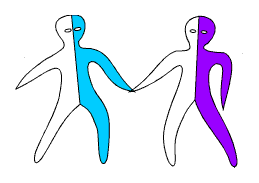Download This Content
APoGI for the Haemoglobin Disorders
![]()
Download This Content ![]()
This is an unusual combination that has not been reported in the literature. The following information is based on general experience with these types of thalassaemia, and available scientific knowledge.
This couple could have a child with haemoglobin E/Lepore thalassaemia.
| Partner who carries haemoglobin Lepore thalassaemia |  |
Partner who carries haemoglobin E | |
 |
 |
 |
 |
| Not a carrier | Carrier of haemoglobin Lepore thalassaemia | Carrier of haemoglobin E | Child with haemoglobin E/Lepore thalassaemia |
In each pregnancy, there are four possibilities:
In each pregnancy there is a 3 out of 4 chance of a healthy child, and a 1 in 4 chance of child with haemoglobin E/Lepore thalassaemia.
... is a form of haemoglobin E/beta thalassaemia. This is a serious inherited anaemia. A few people with haemoglobin E/beta thalassaemia are healthy all their life. Most are anaemic and need extra care. Some need a blood transfusion every month, for life.
We cannot reliably predict which children will have mild, moderate or severe haemoglobin E/Lepore thalassaemia.
It is possible to test a baby for Haemogobin E/Lepore thalassaemia early in pregnancy. This couple should see an expert counsellor in haemoglobin disorders to discuss their options. They should do this before starting a pregnancy, or as early in pregnancy as possible.
![]()
![]() Adobe Acrobat format (PDF) in colour and black-and-white
Adobe Acrobat format (PDF) in colour and black-and-white
![]() Microsoft Rich Text Format in colour and black-and-white
Microsoft Rich Text Format in colour and black-and-white
![]()
These documents are part of the APoGI May 1998 (Evaluation) Release and are made available subject to the APoGI Disclaimers covering usage, distribution and copying.
Problems or further enquiries to APoGI@chime.ucl.ac.uk or the APoGI Contacts
Copyright © 1984 -1998 UCL Medical School. All rights reserved.